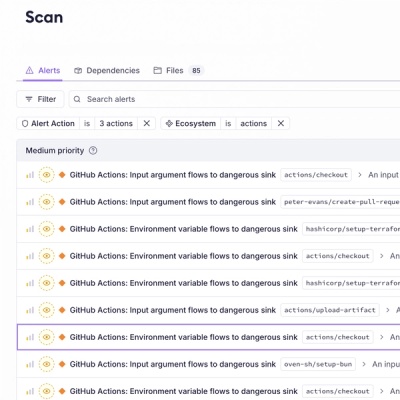
Product
Introducing GitHub Actions Scanning Support
Detect malware, unsafe data flows, and license issues in GitHub Actions with Socket’s new workflow scanning support.
JSON-e is a data-structure parameterization system written for embedding context in JSON objects.
The central idea is to treat a data structure as a "template" and transform it, using another data structure as context, to produce an output data structure.
There are countless libraries to do this with strings, such as mustache. What makes JSON-e unique is that it operates on data structures, not on their textual representation. This allows input to be written in a number of formats (JSON, YAML, etc.) or even generated dynamically. It also means that the output cannot be "invalid", even when including large chunks of contextual data.
JSON-e is also designed to be safe for use on untrusted data. It never uses
eval or any other function that might result in arbitrary code execution. It
also disallows unbounded iteration, so any JSON-e rendering operation will
finish in finite time.
The JS module exposes following interface:
import jsone from 'json-e';
var template = {a: {$eval: "foo.bar"}};
var context = {foo: {bar: "zoo"}};
console.log(jsone(template, context));
// -> { a: 'zoo' }
Note that the context can contain functions, and those functions can be called from the template:
var template = {$eval: "foo(1)"};
var context = {"foo": function(x) { return x + 2; }};
console.log(jsone(template, context));
// -> 3
The examples here are given in YAML for ease of reading. Of course, the rendering operation takes place on the parsed data, so the input format is irrelevant to its operation.
All JSON-e directives involve the $ character, so a template without any directives is
rendered unchanged:
context: {}
template: {key: [1,2,{key2: 'val', key3: 1}, true], f: false}
result: {key: [1,2,{key2: 'val', key3: 1}, true], f: false}
The simplest form of substitution occurs within strings, using ${..}:
context: {key: 'world', num: 1}
template: {message: 'hello ${key}', 'k=${num}': true}
result: {message: 'hello world', 'k=1': true}
The bit inside the ${..} is an expression, and must evaluate to something
that interpolates obviously into a string (so, a string, number, boolean, or
null). The expression syntax is described in more detail below.
Values interpolate as their JSON literal values:
context: {num: 3, t: true, f: false, nil: null}
template: ["number: ${num}", "booleans: ${t} ${f}", "null: ${nil}"]
result: ["number: 3", "booleans: true false", "null: null"]
Note that object keys can be interpolated, too:
context: {name: 'foo', value: 'bar'}
template: {"tc_${name}": "${value}"}
result: {"tc_foo": "bar"}
The string ${ can be escaped as $${.
JSON-e defines a bunch of operators. Each is represented as an object with a
property beginning with $. This object can be buried deeply within the
template. Some operators take additional arguments as properties of the same
object.
$evalThe $eval operator evaluates the given expression and is replaced with the
result of that evaluation. Unlike with string interpolation, the result need
not be a string, but can be an arbitrary data structure.
context:
settings:
staging:
transactionBackend: mock
production:
transactionBackend: customerdb
template: {config: {$eval: 'settings.staging'}}
result: {config: {transactionBackend: 'mock'}}
The expression syntax is described in more detail below.
$jsonThe $json operator formats the given value as JSON. It does not evaluate the
value (use $eval for that). While this can be useful in some cases, it is an
unusual case to include a JSON string in a larger data structure.
context: {a: 1, b: 2}
template: {$json: [a, b, {$eval: 'a+b'}, 4]}
result: '["a", "b", 3, 4]'
Many values can be evaluated in context where booleans are required, not just booleans themselves. JSON-e defines the following values as false. Anything else will be true.
context: {a: null, b: [], c: {}, d: "", e: 0, f: false}
template: {$if: 'a || b || c || d || e || f', then: "uh oh", else: "falsy" }
result: "falsy"
$if - then - elseThe $if operator supports conditionals. It evaluates the given value, and
replaces itself with the then or else properties. If either property is
omitted, then the expression is omitted from the parent object.
context: {cond: true}
template: {key: {$if: 'cond', then: 1}, k2: 3}
result: {key: 1, k2: 3}
context: {x: 10}
template: {$if: 'x > 5', then: 1, else: -1}
result: 1
context: {cond: false}
template: [1, {$if: 'cond', else: 2}, 3]
result: [1,2,3]
context: {cond: false}
template: {key: {$if: 'cond', then: 2}, other: 3}
result: {other: 3}
$flattenThe $flatten operator flattens an array of arrays into one array.
context: {}
template: {$flatten: [[1, 2], [3, 4], [5]]}
result: [1, 2, 3, 4, 5]
$flattenDeepThe $flattenDeep operator deeply flattens an array of arrays into one array.
context: {}
template: {$flattenDeep: [[1, [2, [3]]]]}
result: [1, 2, 3]
$fromNowThe $fromNow operator is a shorthand for the built-in function fromNow. It
creates a JSON (ISO 8601) datestamp for a time relative to the current time.
The offset is specified by a sequence of number/unit pairs in a string. For
example:
context: {}
template: {$fromNow: '2 days 1 hour'}
result: '2017-01-19T16:27:20.974Z'
The available units are day, hour, and minute, for all of which a plural
is also accepted.
$letThe $let operator evaluates an expression using a context amended with the
given values. It is analogous to the Haskell where clause.
context: {}
template: {$let: {ts: 100, foo: 200},
in: [{$eval: "ts+foo"}, {$eval: "ts-foo"}, {$eval: "ts*foo"}]}
result: [300, -100, 20000]
The $let operator here added the ts and foo variables to the scope of
the context and accordingly evaluated the in clause using those variables
to return the correct result.
$mapThe $map operator evaluates an expression for each value of the given array,
constructing the result as an array of the evaluated values.
context: {a: 1}
template:
$map: [2, 4, 6]
each(x): {$eval: 'x + a'}
result: [3, 5, 7]
The array is the value of the $map property, and the expression to evaluate
is given by each(var) where var is the name of the variable containing each
element.
$mergeThe $merge operator merges an array of objects, returning a single object
that combines all of the objects in the array, where the right-side objects
overwrite the values of the left-side ones.
context: {}
template: {$merge: [{a: 1, b: 1}, {b: 2, c: 3}, {d: 4}]}
result: {a: 1, b: 2, c: 3, d: 4}
$sortThe $sort operator sorts the given array. It takes a by(var) property which
should evaluate to a comparable value for each element. The by(var) property
defaults to the identity function.
context: {}
template:
$sort: [{a: 2}, {a: 1, b: []}, {a: 3}]
by(x): 'x.a'
result: [{a: 1, b: []}, {a: 2}, {a: 3}]
$reverseThe $reverse operator simply reverses the given array.
context: {}
template: {$reverse: [3, 4, 1, 2]}
result: [2, 1, 4, 3]
You can use $$ to escape json-e operators. For example:
context: {}
template: {$$reverse: [3, 2, {$$eval: '2 - 1'}, 0]}
result: {$reverse: [3, 2, {$eval: '2 - 1'}, 0]}
Expression are given in a simple Python- or JavaScript-like language. It supports the following:
' or ", with no escaping)[.., ..]){"foo": 10} or {foo: 10}(a + b) * c)+, -, *, /, ** for exponentiation), with unary - and ++)<, <=, >, >=)==, !=)||, &&, !)/[a-zA-Z_][a-zA-Z_0-9]*/)obj.prop or obj["prop"]
obj,prop is an error if there is no such property; in the same case obj["prop"] evaluates to null.array[1] -- second element of array (zero-indexed)array[1:4] -- second through fourth elements of the array (the slice includes the left index and excludes the right index)array[1:] -- second through last element of the arrayarray[:3] -- first through third element of the arrayarray[-2:] -- the last two elements of the arrayarray[:-1] -- all but the last element of the arraystring[3] -- fourth character of the stringstring[-4:] -- all but the last four characters of the string"string" in object -- true if the object has the given property"string" in array -- true if the string is an array elementnumber in array -- true if the number is an array element"string" in "another string" -- true if the first string is a substring of the secondfn(arg1, arg2)The expression language provides a laundry-list of built-in functions. Library users can easily add additional functions, or override the built-ins, as part of the context.
fromNow(x) -- JSON datestamp for a time relative to the current timemin(a, b, ..) -- the smallest of the argumentsmax(a, b, ..) -- the largest of the argumentssqrt(x), ceil(x), floor(x), abs(x) -- mathematical functionslowercase(s), uppercase(s) -- convert string casestr(x) -- convert string, number, boolean, or array to stringlen(x) -- length of a string or arrayThe context supplied to JSON-e can contain JS function objects. These will be available just like the built-in functions are. For example:
var context = {
imageData: function(img) {
return ...;
},
};
var template = {
title: "Trip to Hawaii",
thumbnail: {$eval: 'imageData("hawaii")'},
};
return jsone(template, context);
NOTE: Context functions are called synchronously. Any complex asynchronous operations should be handled before rendering the template.
NOTE: If the template is untrusted, it can pass arbitrary data to functions
in the context, which must guard against such behavior. For example, if the
imageData function above reads data from a file, it must sanitize the
filename before opening it.
You should run npm install to install the required packages for json-e's
execution and development.
You can run ./test.sh to run json-e's unit tests and the bundle.js check.
This is a breakdown of the commands inside the test.sh file.
# Run JavaScript unit tests
npm test
# Run Python unit tests
python setup.py test
# bundle.js check. This section makes sure that
# the demo website's bundle.js file is updated.
mv docs/bundle.js docs/bundle.diff.js
npm run-script build-demo
diff docs/bundle.js docs/bundle.diff.js
You can also run the following command to update the demo website bundle.js file.
npm run-script build-demo
FAQs
json parameterization module inspired from json-parameterization
The npm package json-e receives a total of 48,762 weekly downloads. As such, json-e popularity was classified as popular.
We found that json-e demonstrated a not healthy version release cadence and project activity because the last version was released a year ago. It has 5 open source maintainers collaborating on the project.
Did you know?

Socket for GitHub automatically highlights issues in each pull request and monitors the health of all your open source dependencies. Discover the contents of your packages and block harmful activity before you install or update your dependencies.

Product
Detect malware, unsafe data flows, and license issues in GitHub Actions with Socket’s new workflow scanning support.

Product
Add real-time Socket webhook events to your workflows to automatically receive pull request scan results and security alerts in real time.

Research
The Socket Threat Research Team uncovered malicious NuGet packages typosquatting the popular Nethereum project to steal wallet keys.